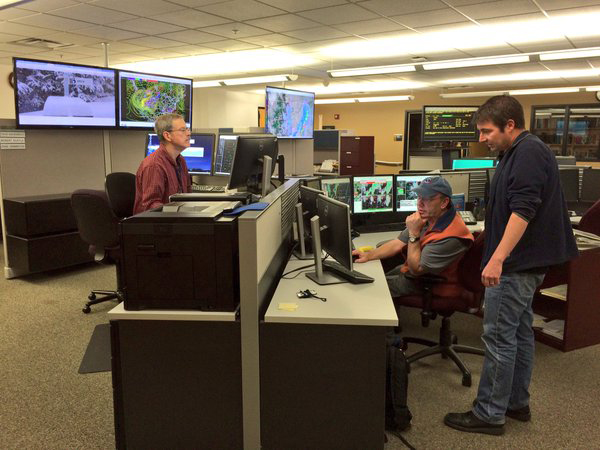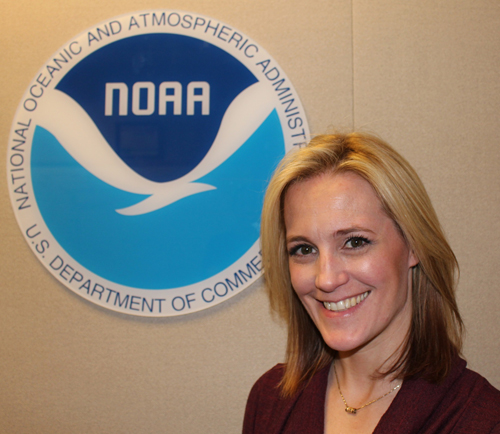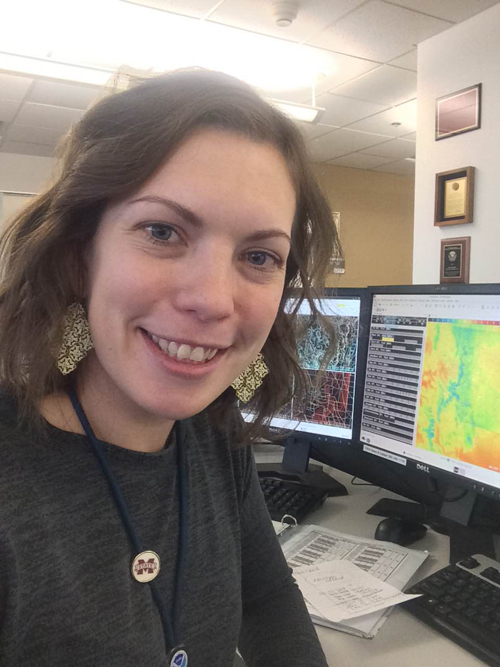
NWS meteorologists are at work 24 hours a day, 365 days a year, from forecast offices located around the United States.
Weather happens every hour of every day and the forecasters at one of the 122 local NWS Weather Forecast Offices (WFO) are the first responders. Starting your workday as a forecaster is just like any other job, except your start time often rotates and is usually either a day, evening, or night shift.
Steve Taylor, Brooke Bingaman, and Kari Bowen are WFO forecasters who experience the impact their jobs have on their local communities every day. Each day as a forecaster is different and provides forecasters with a new challenge.
Steve Taylor is a senior forecaster in Charleston, South Carolina. He is responsible for making sure the office is adequately staffed to handle the workload for the inclement weather, as well as contributing to the forecast himself.
 |
Brooke Bingaman, a meteorologist from the Sacramento, CA WFO, contributes to the forecast through the monitoring of data for both short term and long term forecasts, though her preference is the communications work involving social media, interviews, and talking to the public.
Kari Bowen is an intern for her forecasting office in Boulder, Colorado. Her duties involve forecasting like Bingaman and Taylor, as well as public service—working the phones and weather radios, doing repairs for the precipitation gauge networks, putting out warnings during severe weather, and talking to emergency managers. While their locations and experiences vary, these forecasters comprise the typical day at a WFO.
A day shift will typically have at least three forecasters working together to produce the forecasts. While the routine may be the same, the tasks change every single day. Bowen starts her shifts looking at the temperature instruments first and then will go into compiling notes on the rest of the information and data. Taylor will begin with the task he assigned himself, though forecasting at the near term desk is his favorite as it involves mesoscale meteorology (covering local winds and storm systems) and radar. Bingaman starts her day by looking at the model data, current observations, and how models have been trending. Forecasters use models, including the Global Forecast System model (GFS) and the European model (ECMWF) for long term forecasts and the North American Mesoscale Forecast model (NAM) and the Weather Research and Forecasting model (WRF) for short term forecasts. However, they use their personal experience as well. All three forecasters stressed how important it was to understand and be familiar with their local areas. The topography of Colorado can be difficult for models to interpret, so the microscale feature like upslope wind and its effects must be incorporated into the forecast from experience (especially during the winter!). The Pacific Ocean plays a huge role in the behavior of weather patterns in California, making understanding its behavior crucial for the forecast. As Taylor remarks, “It is so important for the NWS to have local forecasters who know their area. A local WFO can hone down the specifics of the forecasts for their people and make it more personal than one national forecast.”
Every forecaster has an individual responsibility for the day, but they collaborate as a team to make sure the released message is cohesive. Brooke Bingaman reflects this, saying that it is “absolutely critical to work as a team in order to send out a unified message to the public.” After all, the public is the most important motivator when producing forecasts. Forecasters read thousands of bytes of technical data and must relay their observations in a way that anyone can understand. Failure to clarify their message is an issue of safety. Bowen states, “communicating weather is more and more crucial (via social media or in person) and we need to better our skills for hazards now and into the future. Understanding by the public is our job too; we can’t just put out material no one can understand.” There is a wide variety of people who use the forecasts, coming from all different levels of government, to businesses, to travelers. Knowing their risks keeps them safe, so the public needs to have a good understanding of what the forecasts mean. Accuracy and clarity are two important aspects to every forecast that WFO forecasters focus on.
 |
Though from different backgrounds, an interest in weather from an early age unites these forecasters. Taylor was always fascinated with thunderstorms while growing up in coastal North Carolina, leading him to study meteorology. In West Texas at a WFO, he was blown away (pun intended) by experiencing his first synoptic dust storm. Bowen grew up in Texas, unlike Taylor, but she too was amazed by dust storms. Always having been interested in science, she came across weather science in college as an undergraduate and ended up liking the field. Bingaman went back to school for a Master’s degree in meteorology in her late 20’s after discovering her passion for weather from her environmental science background and childhood experiences with severe weather in the Midwest. The devastating effects of hurricanes and floods have made impressions on each of these forecasters. The Colorado Floods of 2013 and Hurricane Katrina in 2005 left Bowen and Bingaman, respectively, in awe of the role forecasts play in saving lives during and after a disaster. After such severe weather events, they are reminded of the true value their jobs have and their passion for their careers becomes more evident to any passerby.
Being a forecaster is more than a job. It takes a person with extraordinary dedication and enthusiasm to work the odd shifts and produce life-saving forecasts. When asked what being a forecaster meant to them, Bowen replied “It’s a new challenge every day. It’s different, but never mundane. It’s a puzzle that I need to put together that is interesting and worthwhile. We try hard every day to make forecasts and get the best information to keep people safe. We’re doing our best and trying to make everything clear.” On her feelings towards being a forecaster, Bingaman states, “I feel that my main job is to (1) do my best to put out the best forecast I can, and (2) make sure the public understands what that means. As scientists, we get caught up in technical jargon that we forget the regular public may not know what vorticity advection is nor how to apply it to their lives. It’s my job to take our information and translate it to the public so they are aware of what they need to know as a community to stay safe.” Along the same lines, Taylor expresses, “[being a forecaster] means a lot. I feel like I impact people’s lives on a daily basis. If I hear that a warning or watch we put out saves someone’s life, it’s incredible.”
Each day as a forecaster begins the same by working with data, models, and experience to produce the best forecast for a broad range of readers. When severe weather strikes, forecasters are the first people to drop what they are working on and swing into action. No matter where you are located, your local forecasting office is working hard to keep you safe every day.